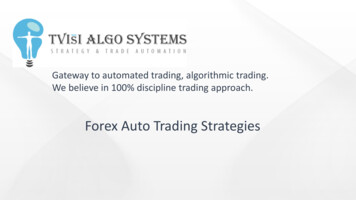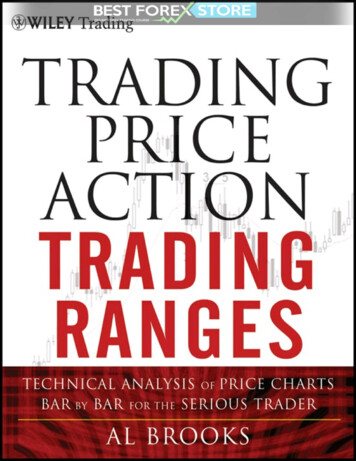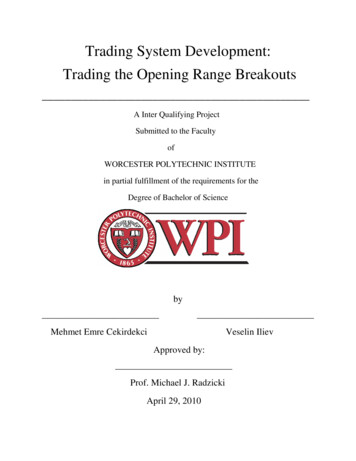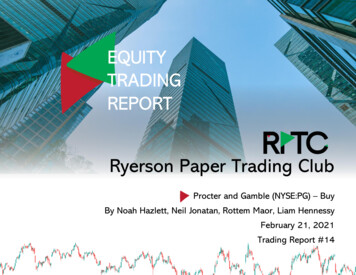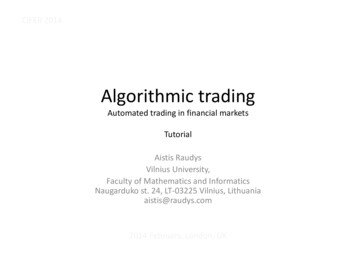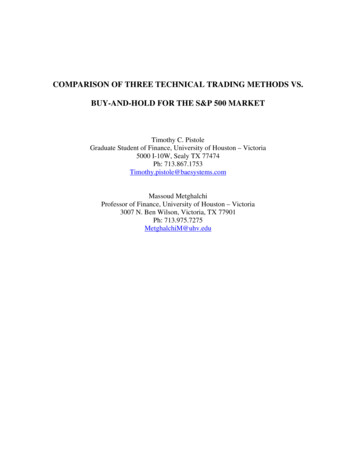
Transcription
COMPARISON OF THREE TECHNICAL TRADING METHODS VS.BUY-AND-HOLD FOR THE S&P 500 MARKETTimothy C. PistoleGraduate Student of Finance, University of Houston – Victoria5000 I-10W, Sealy TX 77474Ph: 713.867.1753Timothy.pistole@baesystems.comMassoud MetghalchiProfessor of Finance, University of Houston – Victoria3007 N. Ben Wilson, Victoria, TX 77901Ph: 713.975.7275MetghalchiM@uhv.edu
ABSTRACTThis paper compares three common technical trading indicators against the buy-andhold strategy for the American S&P 500 index. Data across 17 years and 5 years will beexamined to determine trading method efficiency over long and short terms, with both timeperiods ending in the spring of 2009. An additional study will demonstrate the ability of thetechnical trading methods to correctly position a trader for days when the S&P 500 marketmoves greater than 2% in either direction. The results demonstrate that some, but not all, of thetechnical indicators can be used as a predictive indicator of upcoming market direction whenused in accordance with the methods demonstrated in this report.
I. IntroductionTechnical analysis attempts to predict the price of a futures contract or stock index basedsolely on historical prices and volumes. Pring defines Technical Analysis as follow (Pring 1991,page 3):“Technical analysis is based on the idea that prices move in trends, which are determined by thechanging attitudes of traders towards various economic, political and psychological forces”. AsPring points out “the art of technical analysis is to identify trend changes at an early stage and tomaintain an investment posture until the weight of evidence indicates that the trend hasreversed.”In other words, we define Technical analysis as an approach to forecasting stock andfinancial futures prices which examines patterns of price change, rates of change, and changes involume of trading and open interest, irrespective of underlying fundamental market factors. Wecan also say that Technical analysis is a method of evaluating commodities by analyzingstatistics generated by market activity, volume, open interest, past prices, and various indicatorsbased on prices and volumes. Technical analysts do not attempt to measure a commodity'sintrinsic value; instead they look for patterns and indicators on the charts that will determine awhether you should go long or short or stay neutral for any futures contract.Conversly, Fama (1970) defined an efficient financial market as one in which securityprices always fully reflect the available information; any new information will be quickly andinstantaneously reflected in prices. Furthermore, since news on any company, by definition, isunpredictable (arrives randomly), price changes will be unpredictable or follow a random walk.The “weak-form” Efficient Market Hypothesis (EMH) asserts that stock prices already reflect allinformation that can be derived by investigating market trading data such as the history of pastprices or trading volume. Advocates of the weak-form market efficiency hypothesized thatinvestors could not drive profits above a buy-and-hold strategy using any trading rule thatdepended solely on past market information such as price or volume, implying that technicaltrading rules are useless.After more than three decades of research and literally thousands of journal articles,financial economists and practitioners have not yet reached a consensus whether technicaltrading rules could discern recurring-price patterns for profitable trading. The overwhelmingmajority of financial economists support the “weak-form” efficient market hypothesis. This isbecause much of earlier research supported the random walk hypothesis. The following studieshave long supported the weak-form market efficiency: Larson, (1960); Osborne, (1962);Alexander, (1964); Granger and Morgenstern, (1963); Mandelbrot, (1963); Fama and Blume,(1966); Fama (1965) finds that stock prices indeed follow random walks and he finds nosystematic evidence of profitability of technical trading strategies. Van Horn and Parker (1967)using a simple technical trading rule for 30 NYSE securities confirm the random walkhypothesis. Jensen and Benington (1970) conclude that technical trading rules are not useful. Bythe end of 1970s, the attitude of academics towards technical trading is described by Shleifer(2000, p. 9): “as matters stood at the end of the 1970s, the EMH was indeed one of the greattriumphs of twentieth-century economics.”
However since the early1990s, technical trading has been enjoying a renaissance both onWall Street and in academic circles. Several papers have presented evidence that some simpletrading rules are useful for predicting stock market returns. The cornerstone of this new researchon technical analysis is an article by Brock, Lankonishok and LeBaron (1992), BLL analyzedmoving averages and trading range breaks on the Dow Jones Industrial Index from 1897 to 1985.They used various short and long moving averages of prices to generate buy and sell signals.They tested long moving averages of 50, 150 and 200 days with short averages of 1, 2 and 5days. They point out that “all buy-sell differences are positive and the t-tests for these differencesare highly significant ” and they go on to conclude that their “results are consistent withtechnical rules having predictive power”.Other researchers have used some variants of BLL’s moving averages to investigatewhether stock market indices can be predicted by some simple form of technical analysis.Bessembinder and Chan (1995) conclude that the BBL’s rules are successful in predicting stockprice movement in Japan, Hong Kong, South Korea, Malaysia, Thailand and Taiwan, with thepredictability strongest in the last three markets. Raj and Thurston( 1996) using both the movingaverage rules and trading range break-out for Hang Seng Futures Index conclude that the movingaverage strategy does not produce significant excess return, but trading range break-out rulesproduced significant positive returns for the buy signal. Ergul , Holmes and Priestley (1997),using daily closing prices of 63 stocks traded on the Istanbul Stock Exchange, conclude thattechnical analysis on volume can aid the prediction of returns which cannot be predicted by theanalysis of past returns in isolation. Pruitt and White (1998), using the University of Chicago’sCRSP daily data tapes over the 1976-1985 period, conclude that technical trading rules arecapable of outperforming a simple buy-and-hold strategy even adjusting for transaction costs.Bessembinder and Chan (1998) confirm the basic BLL results; however, they argue that the BLLresults can coexist with the notion of market efficiency when considering transaction costs. Fongand Ho (2001) use technical trading rules for internet stock and conclude that average buy-sellspread is large and significant even after accounting for transaction costs. Gencay, (1998a,1998b); Ratner and Leal, (1999) also support the predictive power of technical trading rules.Kwon and Kish (2002), applying three popular technical trading rules to NYSE index over theperiod 1962-1996, conclude that the technical trading rules have the potential to capture profitopportunities over various models when compared to the buy and hold strategy.However, there are studies that do not support technical strategies. Hudson, Dempsey andKeasey (1996) apply BLL ‘s technical trading rules in the United Kingdom stock market returnover the 1935- 1994 period and conclude that technical trading rules did not generate excessreturns after taking transaction costs of 1 percent per round trip. Szakmary, Davidson, andSchwarz (1999) find that trading rules on individual stock perform poorly but trading rules forthe overall Nasdaq index tend to earn statistically significant abnormal return; however, theybelieve since there is a high level of transaction costs associated with Nasdaq trading, theseabnormal returns are generally not economically significant for them. Coutts and Cheung (2000)analyze the Hang Seng returns from 1985 to 1997 and they conclude that both the movingaverage and trading break-out rules fail to provide positive abnormal returns, net of transaction
costs. Ready (2002) points out that the apparent success of the BLL moving average rules is aspurious result of data snooping and need not persist in the future.Technical trading rules have also been applied to foreign exchange markets. For a surveyof technical trading on foreign exchange markets see Taylor and Allen, (1992); Maillet andMichel, (2000). Hsu and Kuan (2005) find that technical trading rules are profitable for newerindexes such as the NASDAQ Composite or the Russell 2000. Chang et al (2006) appliedmoving average trading rules for Taiwan stock market and conclude that for Taiwan stock indexmoving average rules beats the buy-and-hold stategy. Metghalchi et al. (2008) allied fewmoving average rules with different strategies to Swedish stock market and show that somemoving average rules could beat the buy-and-hold strategy even accounting for transaction costs.Menkohh and Taylor (2007, p.949) survey technical trading rules for currencies and concludethat “ on balance, however, the literature of profitability of technical trading rules tends tosupport the existence of significant profits to be had by employing these rules in the foreignexchange markets”.This paper concentrates upon the S&P 500 Index because that index is a primaryindicator of the movement of all stocks in the US market, and thus and important indicator forstocks in the global market. Additionally, because the S&P 500 is a highly liquid index, a tradercan easily use various S&P 500 ETFs available in the market. In this paper we use threetechnical trading methods and compare them with the “buy-and-hold” strategy commonlyrecommended by efficient market theorists. In the first case, 9-day, 18 day, and 40 day SMA(Simple Moving Averages) were compared to show that the 9-day SMA relative to an 18-daySMA provided the best results. In the second method, the PSAR (Parabolic Stop-and-Reversal)was used to indicate market entry and exit points. Finally, a method based on the RSI (RelativeStrength Index) was compared to determine the best trading strategy for the data set. In addition,these strategies were compared for the period from September 1992 through April 2009, and theshorter term period of May 2004 through April 2009, to determine if the strategies producedsimilar results over the more volatile recent 5 years.Finally, because “big move days” of moves greater than /-2% are important to captureand/or miss, special consideration is given to the ability of each method to correctly place atrader on “big move days.” This 2% aspect is considered important because a few days of largemovements can cause large gains or large losses. So all of the strategies were evaluated forwhich strategy most effectively captures the positive moves of greater than 2%, while avoidingthe negative market move of over -2%.The remainder of this paper is structured as follows: Section II discusses data andmethodology, Section III presents empirical results on technical trading rules, Section IVdemonstrates statistical results, and Section V includes conclusions, followed by references.
II. Data and MethodologyDatastream’s daily open, high, low, and close for the S&P 500 index over the period of7/15/1992, to 4/15/2009 are used to compute daily returns as changes in logarithms of the index.The start date for the data is determined because the open-high-low-close metric for the S&P 500in Datastream is 7/15/1992. Before 7/15/1992, only the closing prices are available. Althoughchanges in stock price index do not include daily dividend yields, we do not expect this omissionto alter the results of our analysis, as Miles and Coutts (1995) review the literatures regardingdividends and conclude that any bias in the results due to dividend exclusion will be minimal.In this study, Moving Average rules, Relative Strength Index method, and PSARtechnique are compared with the buy-and-hold strategy. One of the most important trenddetermining techniques is based on the crossing of two moving averages (MA) of daily closingprices. According to this rule, buy (sell) signals are emitted when the short-term moving averageexceeds (is less than) the long-term moving average. In this study we use long moving averagesof 18 days and the short moving average of 9 days; many technicians use these two movingaverages to go long or short in their daily trading. For example, if the SMA(9) line is above theSMA(18) line, we are in the market. If the opposite is true and the SMA(18) is greater than theSMA(9), we are out of the market and in cash.The second technique that we apply in this paper is to use the very well known RelativeStrength index (RSI) indicator to get in and out of the market. Specifically, we will be in themarket as long as RSI is greater than 50, and will be out of the market as long as the RSI is equalor below 50. The RSI indicator, one of the most popular indicators was invented by WellesWilder, it measures the velocity of directional movement. RSI is a ratio of the upward pricemovement to the total price movement over a given period of days (Wells Wilder suggestedusing 14). Suppose the number of days is N. The calculation of RSI is described below. RSIranges from 0 to 100.AU Average of x days’ up closesAD Average of x days’ down closesRS AUADThen, RSI 100 1001 RSActually, RSI equals toAU 100 , so it is a number between 0 and 100.AU AD
The third method of technical analysis used in this paper is the Parabolic SAR (Stop andReversal) Technical Indicator. The Parabolic SAR, developed by Welles Wilder, is generallyused to set trailing price stops; thus it is a stop-loss system. The stop is continuously moved inthe direction of the position. The indicator is below the prices on the bull market (Up Trend),when it’s bearish (D
Menkohh and Taylor (2007, p.949) survey technical trading rules for currencies and conclude that “ on balance, however, the literature of profitability of technical trading rules tends to support the existence of significant profits to be had by employing these rules in the foreign exchange markets”. This paper concentrates upon the S&P 500 Index because that index is a primary indicator .







